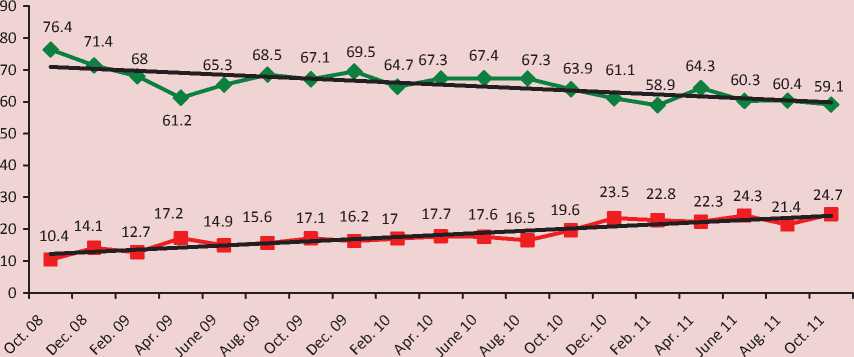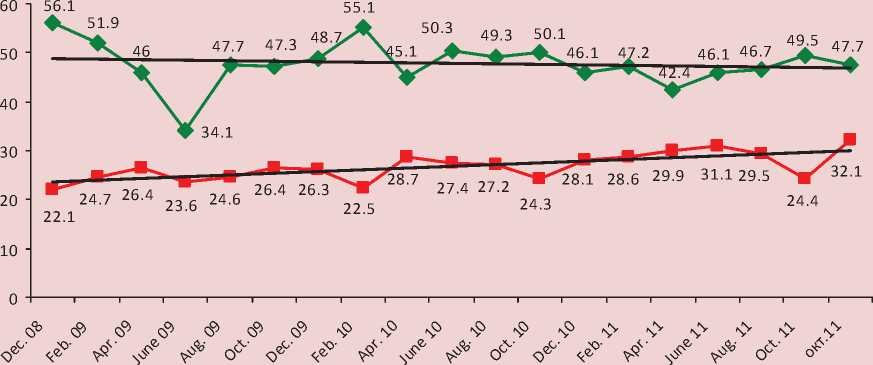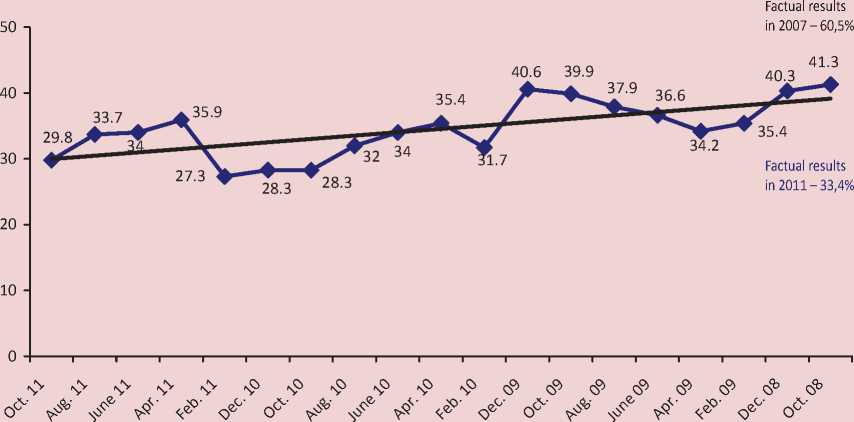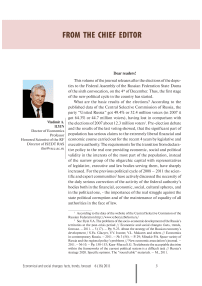From the chief editor
Автор: Ilyin Vladimir Aleksandrovich
Журнал: Economic and Social Changes: Facts, Trends, Forecast @volnc-esc-en
Рубрика: From the chief editor
Статья в выпуске: 6 (18) т.4, 2011 года.
Бесплатный доступ
Короткий адрес: https://sciup.org/147223311
IDR: 147223311
Текст статьи From the chief editor
This volume of the journal releases after the elections of the deputies to the Federal Assembly of the Russian Federation State Duma of the sixth convocation, on the 4 th of December. Thus, the first stage of the new political cycle in the country has started.
What are the basic results of the elections? According to the published data of the Central Selective Commission of Russia, the party “United Russia” got 49.4% or 32.4 million voices (in 2007 it got 64.3% or 44.7 million voices), having lost in comparison with the elections of 2007 about 12.3 million voters 1 . Pre-election debate and the results of the last voting showed, that the significant part of population has serious claims to the extremely liberal financial and economic course carried out for the recent 4 years by legislative and executive authority. The requirements for the transition from declarative policy to the real one providing economic, social and political validity in the interests of the most part of the population, instead of the narrow group of the oligarchic capital with representatives of legislative, executive and law bodies serving them, have sharply increased. For the previous political cycle of 2008 – 2011 the scientific and expert communities 2 have actively discussed the necessity of the duly serious correction of the activity of the federal authority’s bodies both in the financial, economic, social, cultural spheres, and in the political one, - the importance of the real struggle against the state political corruption and of the maintenance of equality of all authorities in the face of law.
The loss by the party in power (“United Russia”) more than 77 deputy mandates (reduction from 315 to 238 places) testifies that the activity of the State Duma of the fifth convocation did not reflect the interests and the values of the considerable part of the Russian society.
Many accepted laws did not meet the requirements of the majority of the population 3 .
The constitutional majority of the deputies of the fifth State Duma appeared to be deaf to such offers of experts from the opposing parliamentary parties and public organizations as:
-
• establishment of the socially optimum level of minimal wages and of the size of pensions;
-
• carrying out the specifications of the budgetary charges (concerning gross national product) on science, education, agriculture, public health services;
-
• introduction of the state monopoly to tobacco and vodka;
-
• introduction of the ascending scale of taxation of personal incomes, including incomes under dividends;
-
• cancellation of the return of the export VAT;
-
• establishment of the tax for the currency export abroad;
-
• toughening the control over offshore operations from Rosfinmonitoring;
-
• giving tax bodies powers for getting the information on the activity of the largest tax bearers, etc.
In the experts’ opinion 4 , all the disadvantages did not allow increasing (almost to two times) the incomes to the federal budget.
As a result, by the present time in Russia almost 85% of regions and more than 90% of the municipal formations are donated (subsidized) for more than 10 years 5 . At the same time, the number of the dollar billionaires 6 in Russia grew from 87 to 101 for the period 2007 – 2011.
Imbalance in the legislative activity of the State Duma influenced the work of representatives and agencies of authority in the subjects of the Federation and the municipal formations, and as a result - on the socio-economic position of these territories.
So, the economy of the Vologda Oblast, as well as of many other regions, has seriously suffered from the world financial crisis in 2008 that at once affected the situation in the social sphere of the region. The ratio between the average monetary incomes of the population and the size of the living wage has reduced recently both in the Russian Federation (from 4.1 to 3.2 times), and the Vologda Oblast (from 3.3 to 2.3), that testifies to falling of the standard of the population’s living (table) .
In the speech at congress of “United Russia” on the 27 th of November, 2011 the Chairman of the Government of the Russian Federation V. V. Putin gave his consent to stand on the post of the head of the state in March, 4, 2012, and declared, that the major principle of the government bodies’ work at all levels should be the social responsibility.
The basic parameters of the social development (in the comparable estimation)
Parameter Territory January – September 2008 2009 2010 2011* 2011 to 2008, % Average real monetary incomes a month, rubles VO 16136 13393 14612 14744 91.4 RF 19262 19262 20225 20185 104.8 VO/RF, % 83.8 69.5 72.2 73.0 x Ratio between the average real monetary incomes and the size of the living wage, times VO 3.3 2.5 2.5 2.3 x RF 4.1 3.7 3.5 3.2 x * Data for January - August. Sources: Social and economic position of the Vologda Oblast in January – September, 2011: report / VologdaStat. – Vologda, October 2011. – P. 123; Social and economic position of the Vologda Oblast in January – September, 2009: report / VologdaStat. – Vologda, October 2009. – P. 122; data of the Federal service of the state statistics’s website (http: // .
“ The development of the country, – he emphasized, – should be carried out for people, instead of due to people. Each our decision, each step should meet the interests of overwhelming majority of the citizens of our country... But businessmen also should understand that to hide actives and the money in “offshore” or to leave social obligations is inadmissible... ”.
However the situation in the country and in the subjects develops in a different way. Both the federal and the regional bodies of the government not only neutral towards to the negatives of the private business, but in many respects specially create legislative grounds for redistribution of the added cost for the benefit of the oligarchic capital.
Let’s result some examples, taken from the executed by the ISEDT RAS analysis of the financial and economic parameters of the activity of Cherepovets, Magnitogorsk and Novolipetsk metallurgical plants 7 .
-
7 In 2011 on the pages of the journals the researches about the influence of the interests of the metallurgical corporations’ proprietors on the national and the regional development were made (Ilyin V.A. The influence of the interests of the metallurgical corporations’ proprietors on the national and the regional development // Economic and social changes: facts, trends, forecast. – 2011. –
The information basis were the annual reports made under the Russian standards of accounting and published in the official sites of the mentioned plants 8 .
-
• By the results of 2010, Magnitogorsk and Novolipetsk metallurgical plants gave the double reduction of the taxable and net profit in comparison with 2007 – 2008; and Cherepovets metallurgical plant has not generated taxable profit and finished 2010 with the loss.
-
• One of the major factors of un-profitability of Cherepovets metallurgical plant was investing of the significant volume of the financial resources on keeping low-margin North American and Italian enterprises. More than 100 billion rubles or 40% of investment charges were spent for their purchase. However, instead of generation of the monetary streams foreign business brought the by-effect as losses and huge debt loading.
-
• As a result of the necessity of financing unprofitable foreign companies the taxable base of Cherepovets metallurgical plant reduced to 56 billion rubles in 2010. The tax to profit of this sum could make: to the federal budget – 1.1 billion rubles, to the regional budget – 10.1 billion rubles.
-
8 According to the data from the websites OJSC “Severstal” ( http://www.severstal.com/rus/ir/disclosers/ financial_ reports/index.phtml), OJSC “MMK” (http:// www.mmk.ru/for_investor/financial_statements/ dynamics/) and OJSC “NLMK” ( http://www.lipetsk . nlmk.ru/about/figures/financial/quarter/).
-
• In 2008 – 2010 at use of the trading circuits of metal products’ export it was deduced 31.1 billion rubles of proceeds of Cherepovets metallurgical plant and more 80 billion rubles of proceeds of Magnitogorsk metallurgical plant from under the Russian taxation. The tax to profit from the specified sums could fill up the budgets of the Vologda and Chelyabinsk Oblasts – 5.6 billion rubles and 14.5 billion rubles accordingly.
-
• The offshore structure of the metallurgical corporations’ property allowed to deduce 30 billion rubles of the net profit of Cherepovets metallurgical plant, 18.6 billion rubles of the net profit of Novolipetsk metallurgical plant and 10 billion rubles of the net profit of Magnitogorsk metallurgical plant at payment of scanty taxes from the head plants in the form of dividends. Regional budgets received less than 2.4 billion rubles of surtax, including the budget of the Vologda Oblast – 1.2 billion rubles from the offshore shares at the Russian metallurgical enterprises.
-
• For 2010 on the background of the sharp deterioration of the final financial result of the metallurgical enterprises’ activity the personal condition of their owners increased:
-
– Lisin V.S. (Novolipetsk metallurgical plant) from 5 to 24 billion dollars;
-
– Mordashov A.A. (Cherepovets metallurgical plant) from 4.3 to 18.5 billion dollars;
– Rashnikov V.F. (Magnitogorsk metallurgical plant) from 2.5 to 11.2 billion dollars.
-
• Dividend payments resulted in the sharp growth of the deficiency of own turnover means the lack of which ferrous metallurgy enterprises’ owners filled due to the scale loans which increased debt loading.
-
• Percentage payments on debts’ service reduced the taxable base of Cherepovets metallurgical plant for 11 billion rubles, Magnitogorsk metallurgical plant - for 2.6 billion rubles, Novolipetsk metallurgical plant – for 4.6 billion rubles.
-
• Cherepovets metallurgical plant will be burdened by liabilities in the volume of 170 billion rubles till 2018.
-
• Administrative expenses which were taken into account, at formation of the taxable profit, made more than 6 billion rubles (at Magnitogorsk and Novolipetsk metallurgical plants) and more than 8 billion rubles (at Cherepovets metallurgical plant). In 2010 the average monthly income of one manager made:
– at Cherepovets metallurgical plant (an aggregate number of managers is 10 people) the managers’ income makes 5.6 million rubles, that exceeds the average workers’ salary (34 thousand a month) 165 times;
– at Magnitogorsk metallurgical plant (an aggregate number of managers is 25 people) the managers’ income makes 1.2 million rubles, that exceeds the average workers’ salary (35 thousand a month) 34 times;
– at Novolipetsk metallurgical plant (an aggregate number of managers is 17 people) the managers’ income makes 1.4 million rubles, that exceeds the average workers’ salary (30 thousand a month) 47 times.
These examples suggest that the federal authorities of Russia have not created legal mechanisms against the rule of oligarchs in the economy that, in particular, allowed during 2008 – 2010 to derive only from the three largest companies in the steel industry to their owners’ foreign accounts 170.3 billion rubles in the form of revenue and net income earned by the labor of thousands of workers in these enterprises. There is a reason to believe that such a situation is in other branches of the raw material orientation. The oligarchic nature of the Russian economy is painfully reflected in the level of profitability of the budget and solving of problems of national and regional development, and becomes a source of tension in the society and can not move towards the implementation of Article 7 of the Constitu-tion 9 .
It seems that in the coming three months before the presidential elections, the candidate for the President of Russia V.V. Putin must clearly emphasize his position on the pressing problems of the Russian reality, defining terms and setting the vector of their solutions, and then, without waiting for the elections, to act in such a way that people could see real movement to eliminate prevailing in the country system of social injustice in the financial, economic, social, cultural, moral and political spheres, and to feel confident that Article 7 of the Constitution of the Russian Federation will be implemented in the next 2 – 3 years in full.
* * *
At this time we publish information on the results of the elections to the State Duma of the fifth and sixth convocations, as well as the results of public assessment of the RF President, the Government, the Governor of the Vologda region in the last 4 years.
The elections to the State Duma of the RF Federal Assembly of the sixth convocation, held on December 4, 2011, led to a change in alignment of political forces in parliament (table) .
The level of support for the “United Russia” in various parts of the country is extremely heterogeneous - from 99% in the Chechen Republic to 29% in the Yaroslavl region. In a twenty of the territories of the Russian Federation, which have rendered the least support to the “party of power” there are 8 of 11 North-West Russian regions: the Arkhangelsk, Murmansk regions, Republic of Karelia (32%), the Vologda, Leningrad regions (33%), the Novgorod region, St. Petersburg (35%), Nenet-sia Autonomous Okrug (36%).
The election results, chief among them - a significant reduction of the electorate of the “United Russia”, were largely the natural result associated with poor rates of post-crisis stabilization, unresolved pressing social problems and a lack of clear prospects for further development of the country.
We can not say that what happened was a big surprise. As the data of sociological studies conducted by ISEDT RAS in the Vologda region in recent years have witnessed a steady increase in popular discontent against the federal and regional leaders (fig. 1 – 4), the proportion of people supporting the party of power decreased (from 41% in October 2008 to 30% in October 2011).
During this period, as well as all the years of our researches, we sent the received information in various federal and regional structures of power, but there was no response to the ongoing negative trend, therefore, we have such results of the elections.
The comparison of results of elections to the State Duma of the RF Federal Assembly of the fifth and sixth convocations (2007 and 2011)
|
The RF |
The Vologda region |
|||
|
2007 |
2011 |
2007 |
2011 |
|
|
Turnout |
63.8 |
60.2 |
66.2 |
56.3 |
|
United Russia |
64.3 |
49.4 |
60.5 |
33.4 |
|
KPRF |
11.6 |
19.2 |
9.3 |
16.8 |
|
LDPR |
8.1 |
11.7 |
11.0 |
15.4 |
|
Just Russia |
7.7 |
13.2 |
8.8 |
27.2 |
|
Apple |
1.6 |
3.4 |
1.1 |
3.5 |
|
Just cause |
- |
0.6 |
- |
0.7 |
|
Patriots of Russia |
0.9 |
1.0 |
0.8 |
1.3 |
Source: According to the website data of the Central Election Commission of the Russian Federation
Figure 1. The a ssessment of the Russian Federation President’s activities ( %)

Approve totally and mainly Disapprove totally and mainly
Linear (Approve totally and mainly) Linear (Disapprove totally and mainly)
Figure 2. The a ssessment of the Prime Minister’s activities (%)

Approve totally and mainly Disapprove totally and mainly
Linear (Approve totally and mainly) Linear (Disapprove totally and mainly)
Figure 3.The assessment of activities of the Vologda Oblast Governor (%)

Approve totally and mainly Disapprove totally and mainly
Linear (Approve totally and mainly) Linear (Disapprove tota lly and ma inly)
Figure 4. The assessment of activities of the Vologda Oblast Governor (%)

j
As in the previous issue, in this one we publish a rating journal articles.
The first 10 articles according to the frequency of their viewing for the recent 12 months (December 2010 – November 2011)
|
< |
E 0 |
E £ ll > 5 |
s |
« E S | ? | 55 у > ^ | = <5 5 |
x -E M "00 |
0 s co |
E Q |
О S |
E Q |
CD ^cd § l 0 > |
|
s |
00 |
E ° |
E ° 0 CsJ Q |
E ° |
00 1 |
E ° O_ C\1 to |
||||
|
03 |
c^ ^ |
^ |
||||||||
|
E ст —. ™ ■5 оз 4— -□ оз 3 S c 0 CT 03 = Qj = ■— s ± E, - 8 8 3 e s " |
▻2 |
CD |
csi |
2: |
LO |
|||||
|
” |
S |
00 |
CD |
Si |
co |
s |
||||
|
fl И 1 “ E Z И CXI 0 t |
CD CO |
CD |
00 |
co |
c^ |
CD |
s |
|||
|
s i s z 8 0 0 ” |
C\J CO |
CD CO |
co |
CD |
csi |
CO |
to |
|||
|
ihh 5 Ё | 5 5 |
CD CD LO |
to |
CD C^ |
CO |
co co c^ |
co |
s |
CO |
co |
|
|
< |
s |
If 5 2 E "S- £ E |
^ > О Q CD |
E ° |
5 .E 2 cd CD E ^ ^ ° C 4-^ ° 00 — ^ CD 5 □) О О О c 0 0 g |
"55 aS 03 ^ c 0 ^ 0 ° O_ 0 co E E cd -p; |
S 0 и E а ш о “ ^ б ° 00 -E "o 0 1— О "о О |
i = Й Ё |
Q3 CO "^ .41 СЛ = CD E cd 00 0 3 "□) GO P f| E I sr f H C2 0 E |
od E g |
|
бицеу |
1- |
csi |
CO |
LO |
co |
co |
CD |
Account of the site’s viewing has been carried out since 2009, December, 12
Список литературы From the chief editor
- Ilyin V.A. The problems of the socio-economic development of the Russia’s territories at the post-crisis period//Economic and social changes: facts, trends, forecast. -2011. -5 (17). -Pp; 9-23
- About the strategy of the Russian economy’s development/S.Yu. Glazyev, V.V. Ivanter, V.L. Makarov and others//Economics in contemporary Russia. -2011. -№ 3 (54). -P. 29
- Minakir P.A. Space variety of Russia and the regional policy’s problems//New economic association’s journal. -2011. -№ 10. -Pp. 150-153
- Kara-Murza S.G. To elaborate the acceptable doctrine within the frameworks of the current political system is a difficult task//Russia’s strategy 2020. Specific opinion. The “round table” materials. -M., 2011.
- Ilyin V.A. The influence of the interests of the metallurgical corporations’ proprietors on the national and the regional development//Economic and social changes: facts, trends, forecast. -2011. -(15). -Pp. 14-38
- Povarova A. The influence of the interests of metallurgical corporations’ proprietors on the financial results of the head plant (by the example of “Severstal”)//Economic and social changes: facts, trends, forecast. -2011. -5 (17). -Pp. 36-51.


